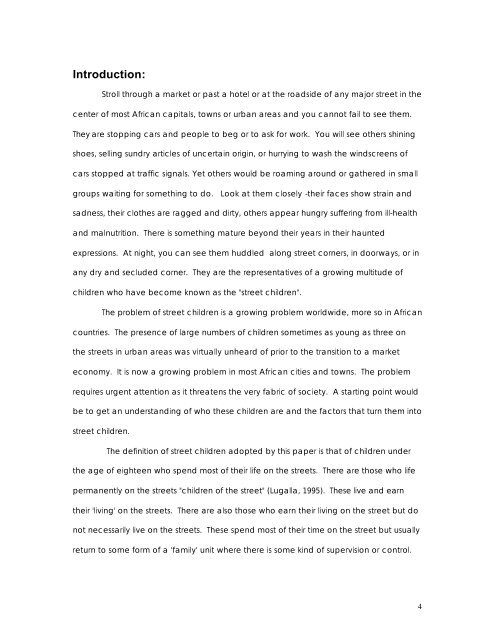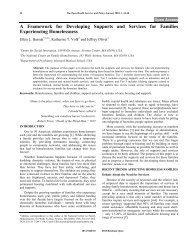international conference on street children and street children's
international conference on street children and street children's
international conference on street children and street children's
You also want an ePaper? Increase the reach of your titles
YUMPU automatically turns print PDFs into web optimized ePapers that Google loves.
Introducti<strong>on</strong>:<br />
Stroll through a market or past a hotel or at the roadside of any major <strong>street</strong> in the<br />
center of most African capitals, towns or urban areas <strong>and</strong> you cannot fail to see them.<br />
They are stopping cars <strong>and</strong> people to beg or to ask for work. You will see others shining<br />
shoes, selling sundry articles of uncertain origin, or hurrying to wash the windscreens of<br />
cars stopped at traffic signals. Yet others would be roaming around or gathered in small<br />
groups waiting for something to do. Look at them closely -their faces show strain <strong>and</strong><br />
sadness, their clothes are ragged <strong>and</strong> dirty, others appear hungry suffering from ill-health<br />
<strong>and</strong> malnutriti<strong>on</strong>. There is something mature bey<strong>on</strong>d their years in their haunted<br />
expressi<strong>on</strong>s. At night, you can see them huddled al<strong>on</strong>g <strong>street</strong> corners, in doorways, or in<br />
any dry <strong>and</strong> secluded corner. They are the representatives of a growing multitude of<br />
<strong>children</strong> who have become known as the "<strong>street</strong> <strong>children</strong>".<br />
The problem of <strong>street</strong> <strong>children</strong> is a growing problem worldwide, more so in African<br />
countries. The presence of large numbers of <strong>children</strong> sometimes as young as three <strong>on</strong><br />
the <strong>street</strong>s in urban areas was virtually unheard of prior to the transiti<strong>on</strong> to a market<br />
ec<strong>on</strong>omy. It is now a growing problem in most African cities <strong>and</strong> towns. The problem<br />
requires urgent attenti<strong>on</strong> as it threatens the very fabric of society. A starting point would<br />
be to get an underst<strong>and</strong>ing of who these <strong>children</strong> are <strong>and</strong> the factors that turn them into<br />
<strong>street</strong> <strong>children</strong>.<br />
The definiti<strong>on</strong> of <strong>street</strong> <strong>children</strong> adopted by this paper is that of <strong>children</strong> under<br />
the age of eighteen who spend most of their life <strong>on</strong> the <strong>street</strong>s. There are those who life<br />
permanently <strong>on</strong> the <strong>street</strong>s "<strong>children</strong> of the <strong>street</strong>" (Lugalla, 1995). These live <strong>and</strong> earn<br />
their 'living' <strong>on</strong> the <strong>street</strong>s. There are also those who earn their living <strong>on</strong> the <strong>street</strong> but do<br />
not necessarily live <strong>on</strong> the <strong>street</strong>s. These spend most of their time <strong>on</strong> the <strong>street</strong> but usually<br />
return to some form of a 'family' unit where there is some kind of supervisi<strong>on</strong> or c<strong>on</strong>trol.<br />
4
















